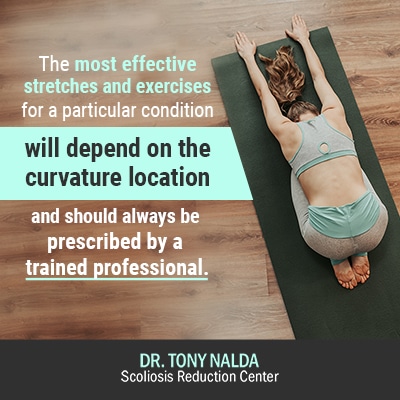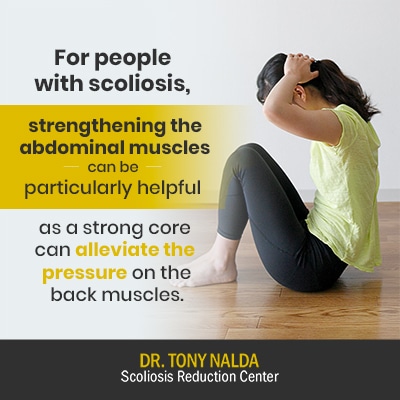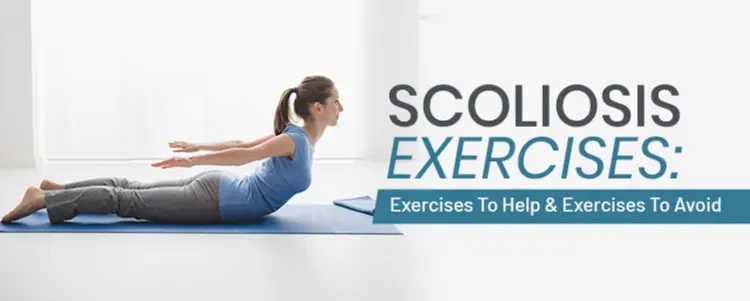There was a time when the place of exercise in scoliosis treatment was questioned. Now, we know that not only are scoliosis-specific exercises an important part of a customized treatment plan, we also know they are an important tool for managing life with scoliosis throughout treatment and beyond.
When scoliosis exercises are prescribed by a professional and integrated into a functional treatment plan, they can increase spinal flexibility and help strengthen the muscles that support and stabilize the spine. Exercises to avoid are those that strain the back or play into the condition’s asymmetry.
While no form of exercise should be attempted without first discussing it with the provider of your scoliosis treatment, when designed by a professional, scoliosis-specific exercise can help preserve the spine’s overall health and function, making it more responsive to treatment.
Scoliosis-Specific Exercises
Patients who come to see me at the Scoliosis Reduction Center® have access to multiple treatment disciplines as I integrate different forms of treatment for a truly customized approach.
Scoliosis-specific exercises (SSEs) are customized for each patient to suit their ability and curvature type; they include reflexive, movement-based, and isometric exercises.
As a scoliosis chiropractor, I know the spine, and I know scoliosis, so I have a comprehensive understanding of how different scoliosis-specific treatment disciplines complement one another to achieve the best results.
With professional guidance, patients can incorporate SSEs into activities they are already doing and value, and ensure that the chosen exercises have the potential to help, rather than hinder, their scoliosis treatment.
Here at the Center, each and every patient is comprehensively evaluated and given a set of SSEs that are designed specifically for them. The SSEs will complement the other treatment disciplines applied, that are also patient- and scoliosis-specific: chiropractic care and specialized corrective bracing, when prescribed.
When these different facets of treatment are combined and customized, it creates a powerful and effective approach with the potential to deliver measurable functional improvements.
Now that we’ve discussed the power and place of SSEs in designing effective treatment plans for patients, let’s take a look at some specific scoliosis-friendly exercises/stretches.
One of the issues that develops with scoliosis is spinal rigidity; this tends to get worse as a condition progresses, especially if left untreated, and stretching/exercise can be a beneficial counteractive measure.
Stretching and Exercises to Help with Scoliosis
As a scoliotic spine gets more rigid, this also affects the surrounding muscles that help provide it with support and stabilization.
Stretching/exercising done in a symmetrical manner can provide relief from muscle tension and stiffness. Keeping the spine and its surrounding muscles as loose and flexible as possible means preserving the spine’s function and range of motion; in doing so, the spine’s overall health is improved so it’s more responsive to treatment.

The most effective stretches and exercises for a particular condition will depend on the curvature location and should always be prescribed by a trained professional. For those with curvatures of the lumbar spine (lower back), they should focus exercises and stretches on the lower back; people with curvatures of the thoracic spine (middle/upper back) should focus on the shoulder and upper-body area.
This is why it’s so important to seek guidance from a practitioner who focuses on scoliosis so exercise regimes are condition-specific and the most beneficial. In addition, SSEs are only an effective part of treatment if they are designed to complement other applied treatment disciplines.
I have to be clear that no exercise/exercise plan on its own has the potential to impact a person’s scoliosis on a structural level, meaning a curvature reduction, but when integrated into a proactive and functional treatment approach, they can augment treatment results and help in sustaining those results after the most intense portion of treatment is completed.
Yoga, for example, can be beneficial for people with scoliosis in terms of pain relief, but if relied on alone to impact scoliosis structurally, it does not have the power to do so, nor do other general exercises that are not scoliosis-specific.
There is no shortage of effective and scoliosis-friendly stretches and exercises to choose from, but let’s focus on a few that can be particularly helpful: hip flexion, the child’s pose, the pelvic tilt, latissimus dorsi stretching, and the abdominal stretch.
Hip Flexion Stretch
The hip flexion stretch is a great way to open up the hips and keep them as loose as possible.
With scoliosis, the uneven forces introduced to the body can produce asymmetrical postural changes, one of which is uneven hips; one can sit higher than the other, or one hip appears more rounded or flat than the other, making the pelvis appear tilted, and the muscles on one side of the body becoming overly tight.
When the hips experience an uneven postural change, one side is bearing more weight than the other, and this can cause pain and discomfort, not to mention place added strain on the surrounding muscles.
The hip flexor muscle group attaches to the femur (thigh bone), the pelvis, and the lumbar spine (lower back), and allows the lifting of legs towards the torso. The hip flexor muscles keep the hips and lower back strong, flexible, and in a healthy alignment.
The hip flexion stretch is a simple stretch with the potential to alleviate scoliosis-related hip pain and keep the surrounding muscles loose by working them in a way that encourages proper alignment of the hips and lower back.
The hip flexor stretch is done with the following three simple steps:
- For people experiencing tightness on the right side, kneel on the right leg, and bend the left leg out in front of you while keeping the left foot flat on the floor. For those experiencing tightness on the left side, do the opposite.
- Keep the back straight and slowly extend the hips forward until a stretch is felt in the upper thigh of the right leg and hip
- Hold the pose to stretch for 15 to 30 seconds
When stretches are done in a symmetrical manner, they can be an effective element of treatment by keeping the spine, hips, and their surrounding muscles as loose and flexible as possible, counteracting the stiffness and rigidity that tends to accompany curvature progression.
Child’s Pose
The child’s pose is an effective means of lengthening and stretching the spine. It can relieve neck and lower-back pain when performed with the torso and head supported.
When done correctly, the child’s pose gently stretches the hips, thighs, and ankles. As scoliosis progression can lead to spinal rigidity, stretching can be an effective way of keeping the spine and its surrounding muscles loose, flexible, and strong, enabling their support and stabilization of the spine.
Child’s pose steps include:
- Kneeling on the floor with the toes together and the knees kept hip-width apart, while resting the palms on the tops of the thighs.
- Taking a deep breath, and on the exhale, lowering the torso between the knees.
- Extending the arms alongside the torso with the palms facing downwards.
- Relaxing the shoulders towards the ground.
- Hold the pose for as long as it feels good to do so.
Pelvic Tilt
The pelvic tilt is a great way to stretch tight hip and lower-back muscles so is ideal for patients with lumbar curvatures.
The pelvic tilt is simple, highly effective, and involves:
- Lying on the back with the feet flat on the floor and knees bent.
- Engaging the core by tightening the abdominal muscles while flattening the back into the floor.
- Holding the pose for 5 seconds while keeping breathing steady.
- Releasing the pose and repeating for two sets of 10.
Latissimus Dorsi Stretch
The latissimus dorsi is the largest muscle of the upper body, and thoracic scoliosis directly affects the latissimus dorsi muscles. People with lumbar scoliosis can also benefit from this stretch as related back tension can extend upwards, above the curvature sight, also affecting the latissimus dorsi muscles.
Stretching the latissimus dorsi muscles involves:
- Standing with a neutral and aligned posture.
- With the feet shoulder-width apart, bending slightly at the knees.
- Reaching over the head with both hands and grasping the right wrist with the left hand.
- Bending gently towards the right side until a stretch is felt in the body’s left side
- Hold for five seconds, then repeat on the opposite side.
- Five to 10 repetitions on each side should effectively stretch this important muscle group.
Abdominal Press

For people with scoliosis, strengthening the abdominal muscles can be particularly helpful as a strong core can alleviate the pressure on the back muscles. In addition, strong abdominal muscles help with postural issues.
An abdominal press involves:
- Lying on the floor with the feet flat against the floor and the knees bent.
- Keep the back in a neutral and relaxed position.
- Raising both lower legs above the floor in a 90-degree angle (having them rest on a chair seat is helpful)
- Using the hands to push down on the knees while pulling the knees towards the hands simultaneously, creating resistance.
- Keep the legs and arms still while pressing.
- Hold for seven seconds and do two sets of 10.
Increasing core strength is an important part of our customized treatment plans here at the Center as the spine’s ability to maintain its healthy and natural curvatures is affected by the strength of its surrounding muscles.
Exercises and Stretches to Avoid
As we’ve talked about some exercises and stretches that help with scoliosis, both in terms of pain relief and increasing spinal/muscle strength and flexibility, let’s touch on some exercises and stretches that people with scoliosis should avoid.
In addition, I should also mention that there is an important distinction between SSE’s and general exercise like working out. SSE’s are specific to the condition and when combined with other effective treatment disciplines, can actually play a role in impacting the condition structurally, but that result is beyond the scope of general exercise.
While every case is different with its own treatment-plan needs, in general, exercises and stretches that involve the spine not being held in a neutral/relaxed position can further expose a scoliotic spine to adverse tension.
For those living with scoliosis, their spines are already exposed to adverse spinal tension, so the goal of scoliosis-friendly exercises and stretches is to reduce the effects of that tension, which tend to be spinal rigidity and strained/uneven working of the muscles closely surrounding the spine.
Exercises and stretches that overuse one side of the body and don’t work its muscles in a symmetrical manner are not helpful for scoliosis as the condition’s uneven forces are already making one side of the body work harder than the other.
Some exercises and stretches known to worsen scoliosis symptoms include those that keep the cervical spine (neck) bent forward, as this increases the weight of the head on the cervical spine, and the surrounding neck, upper back, and shoulder muscles.
When it comes to exercises that expose the spine to repeated jarring impacts such as jumping, running on flat surfaces, and horseback riding are not ideal for people living with scoliosis as the scoliotic spine is already facing compression from the abnormal curvature.
Repeatedly extending the torso, such as in ballet or gymnastics, can strain the thoracic spine and the core muscles, and this can compromise their ability to provide the spine with adequate support and stabilization: necessary to maintain the spine’s natural and healthy curvatures.
Conclusion
When it comes to effective scoliosis exercises, it’s all about keeping the spine and its surrounding muscles as loose and flexible as possible.
In addition, increasing core strength can be particularly beneficial for people with scoliosis as strong abdominal muscles means the back muscles don’t need to work as hard to support and stabilize the spine.
Here at the Scoliosis Reduction Center®, patient-specific SSEs are an integral component of our customized treatment plans as they help naturally strengthen the spine and its surrounding muscles.
Scoliosis-friendly exercises/stretches are also an effective means of managing any scoliosis-related back and/or muscle pain, as well as promoting good posture, balance, and coordination: all things that scoliosis can adversely affect.
Again, while exercises and stretches can play a large part in increasing the spine’s overall health and function, in order to impact a person’s condition effectively, they have to be scoliosis-specific and address the particulars of a patient’s condition, such as curvature location.
It’s also important to understand that as scoliosis is structural, an effective treatment plan has to, first and foremost, impact the condition on a structural level, and no exercise alone can accomplish that; however, when combined with other scoliosis-specific treatment disciplines, SSEs have the potential to augment treatment results and help in sustaining those results throughout treatment and beyond.





